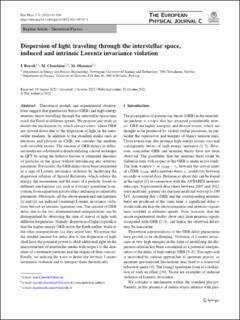| dc.contributor.author | Brevik, Iver Håkon | |
| dc.contributor.author | Chaichian, Masud | |
| dc.contributor.author | Oksanen, Markku | |
| dc.date.accessioned | 2022-12-07T08:40:47Z | |
| dc.date.available | 2022-12-07T08:40:47Z | |
| dc.date.created | 2021-11-17T13:12:22Z | |
| dc.date.issued | 2021 | |
| dc.identifier.citation | European Physical Journal C. 2021, 81 . | en_US |
| dc.identifier.issn | 1434-6044 | |
| dc.identifier.uri | https://hdl.handle.net/11250/3036258 | |
| dc.description.abstract | Theoretical models and experimental observations suggest that gamma-ray bursts (GRB) and high-energy neutrino bursts travelling through the interstellar space may reach the Earth at different speeds. We propose and study in details the mechanism (i), which always exists, where GRB are slowed down due to the dispersion of light in the interstellar medium. In addition to the standard media such as electrons and photons as CMB, we consider the medium with invisible axions. The amount of GRB delays in different media are calculated in details utilizing a novel technique in QFT by using the hitherto known or estimated densities of particles in the space without introducing any arbitrary parameter. Previously, the GRB delays have been interpreted as a sign of Lorentz invariance violation by modifying the dispersion relation of Special Relativity, which relates the energy, the momentum and the mass of a particle, based on different mechanisms (ii), such as a stringy spacetime foam, coming from a quantum gravity effect and using an adjustable parameter. Obviously, all the above-mentioned mechanisms (i) and (ii) are induced (seeming) Lorentz invariance violations but not an intrinsic (genuine) one. The amount of GRB delay due to the two aforementioned interpretations can be distinguished by observing the time of arrival of light with different frequencies. Namely, dispersion of light (i) predicts that the higher energy GRB arrive the Earth earlier, while in the other interpretations (ii), they arrive later. We notice that the needed amount for delay due to the dispersion of light shall have the potential power to shed additional light on the microstructure of interstellar media with respect to the densities of constituent particles and the origins of their sources. Finally, we indicate the ways to detect the intrinsic Lorentz invariance violation and to interpret them theoretically. | en_US |
| dc.language.iso | eng | en_US |
| dc.publisher | Springer | en_US |
| dc.relation.uri | https://arxiv.org/abs/2101.00954 | |
| dc.rights | Navngivelse 4.0 Internasjonal | * |
| dc.rights.uri | http://creativecommons.org/licenses/by/4.0/deed.no | * |
| dc.title | Dispersion of light traveling through the interstellar space, induced and intrinsic Lorentz invariance violation | en_US |
| dc.title.alternative | Dispersion of light traveling through the interstellar space, induced and intrinsic Lorentz invariance violation | en_US |
| dc.type | Peer reviewed | en_US |
| dc.type | Journal article | en_US |
| dc.description.version | publishedVersion | en_US |
| dc.source.pagenumber | 15 | en_US |
| dc.source.volume | 81 | en_US |
| dc.source.journal | European Physical Journal C | en_US |
| dc.identifier.doi | 10.1140/epjc/s10052-021-09707-3 | |
| dc.identifier.cristin | 1955542 | |
| cristin.ispublished | true | |
| cristin.fulltext | original | |
| cristin.qualitycode | 2 | |

